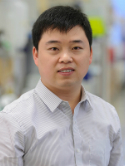An embryonic diapause-like adaptation with suppressed Myc activity enables tumor treatment persistence Journal Article
| Authors: | Dhimolea, E.; de Matos Simoes, R.; Kansara, D.; Al'Khafaji, A.; Bouyssou, J.; Weng, X.; Sharma, S.; Raja, J.; Awate, P.; Shirasaki, R.; Tang, H.; Glassner, B. J.; Liu, Z.; Gao, D.; Bryan, J.; Bender, S.; Roth, J.; Scheffer, M.; Jeselsohn, R.; Gray, N. S.; Georgakoudi, I.; Vazquez, F.; Tsherniak, A.; Chen, Y.; Welm, A.; Duy, C.; Melnick, A.; Bartholdy, B.; Brown, M.; Culhane, A. C.; Mitsiades, C. S. |
| Article Title: | An embryonic diapause-like adaptation with suppressed Myc activity enables tumor treatment persistence |
| Abstract: | Treatment-persistent residual tumors impede curative cancer therapy. To understand this cancer cell state we generated models of treatment persistence that simulate the residual tumors. We observe that treatment-persistent tumor cells in organoids, xenografts, and cancer patients adopt a distinct and reversible transcriptional program resembling that of embryonic diapause, a dormant stage of suspended development triggered by stress and associated with suppressed Myc activity and overall biosynthesis. In cancer cells, depleting Myc or inhibiting Brd4, a Myc transcriptional co-activator, attenuates drug cytotoxicity through a dormant diapause-like adaptation with reduced apoptotic priming. Conversely, inducible Myc upregulation enhances acute chemotherapeutic activity. Maintaining residual cells in dormancy after chemotherapy by inhibiting Myc activity or interfering with the diapause-like adaptation by inhibiting cyclin-dependent kinase 9 represent potential therapeutic strategies against chemotherapy-persistent tumor cells. Our study demonstrates that cancer co-opts a mechanism similar to diapause with adaptive inactivation of Myc to persist during treatment. © 2020 Elsevier Inc. Dhimolea et al. document that cancer cell persistence during cytotoxic treatment is enabled by Myc inactivation and a biosynthetically paused adaptation resembling embryonic diapause. Myc-suppressed cancer cells have low redox stress and attenuated apoptotic priming. Interfering with this adaptive response of chemo-persistent cells enhances their chemosensitivity. © 2020 Elsevier Inc. |
| Keywords: | breast cancer; prostate cancer; myc; cancer; cdk9; crispr; residual tumor; diapause; adaptation to stress; drug persistence |
| Journal Title: | Cancer Cell |
| Volume: | 39 |
| Issue: | 2 |
| ISSN: | 1535-6108 |
| Publisher: | Cell Press |
| Date Published: | 2021-02-08 |
| Start Page: | 240 |
| End Page: | 256.e11 |
| Language: | English |
| DOI: | 10.1016/j.ccell.2020.12.002 |
| PUBMED: | 33417832 |
| PROVIDER: | scopus |
| PMCID: | PMC8670073 |
| DOI/URL: | |
| Notes: | Article -- Export Date: 1 March 2021 -- Source: Scopus |
Altmetric
Citation Impact
BMJ Impact Analytics
Related MSK Work





